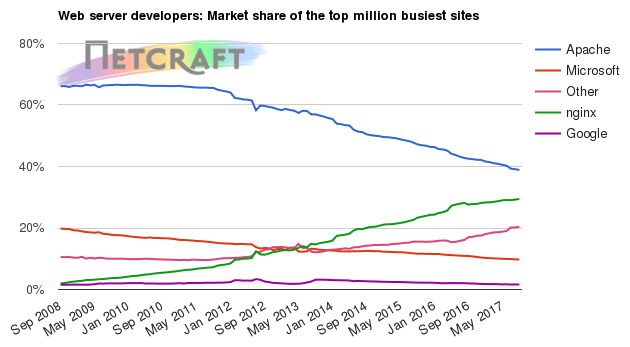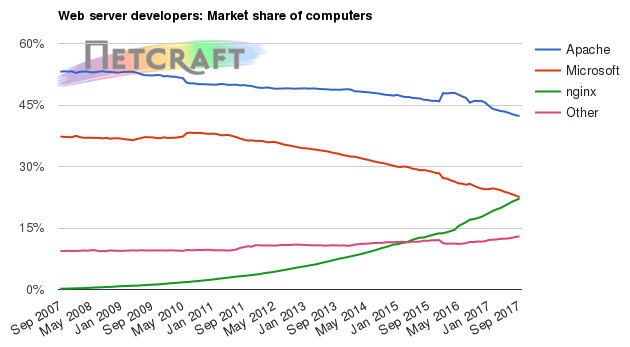In the September 2017 survey we received responses from 1,805,060,730 sites and 6,798,101 web-facing computers, reflecting a gain of 4.49 million sites and 84,800 computers. This is the largest number of web-facing computers in history, and cloud computing has helped fuel this growth considerably. The top three cloud hosting providers—Amazon, Alibaba and DigitalOcean—now account for nearly 22% of all web-facing computers, as well as more than a third of this month's net computer growth.
nginx has dominated this month's computer growth once again, with an additional 49,900 computers taking its market share up to 22.2%. This puts it within 20,000 computers of Microsoft's 22.5% share, giving nginx a realistic chance of taking second place by next month. Meanwhile, Apache remains far ahead in the lead with 2.88 million web-facing computers giving it a 42.3% share of the market.
While more than half of the websites in the survey are using Microsoft web server software, relatively few of these are active sites. Discounting link farms, domain holding pages and other automatically generated content, Microsoft accounts for only 7.3% of all active sites, while Apache leads with 44.9%, and nginx follows with 20.7%. Microsoft's active sites share has never exceeded Apache's, and ever since it peaked at 38% in early 2009, it has experienced a general decline.
Microsoft's presence within the top million websites has also been steadily declining – in 2008, it had a 20% share, but this has since dwindled to less than 10%. Today, 9.73% of the top million sites use Microsoft web server software (mostly IIS – Internet Information Services), while Apache leads with 38.9%. However, Apache has also been experiencing a general decline since 2011, while nginx has continued to muscle its way in. A further 1,299 nginx-powered sites made their way into the top million this month, lifting nginx's share to 29.4%.
Web-facing operating systems
Apache has been the most commonly installed web server for many years, but which underlying operating systems are used by the world's web facing computers?
By far the most commonly used operating system is Linux, which runs on more than two-thirds of all web-facing computers. This month alone, the number of Linux computers increased by more than 91,000; and again, this strong growth can largely be attributed to cloud hosting providers, where Linux-based instances are typically the cheapest and most commonly available.
It is difficult to distinguish different Linux distributions by examining their TCP/IP characteristics, but inferences can be made from other clues, such as Server headers. The Linux distribution can be positively identified in around 30% of cases, and of these 1.39 million Linux computers, just over half are running Ubuntu Linux, nearly a quarter are running CentOS, and around fifth are running Debian Linux.
Microsoft is next up, with 26.8% of all web-facing computers running various versions of Windows Server. Interestingly, this is higher than Microsoft's web server share (22.5%), and can be explained by around 20% of Windows computers being used to run other web server software – such as Apache and nginx – rather than its native Microsoft IIS web server. Conversely, around 51,000 Linux computers expose Microsoft IIS web servers to the internet – in these cases, the Linux frontends are typically acting as load balancers or reverse proxies to backend Windows computers running IIS.
Windows Server 2008 is the most commonly used version of the Windows Server family of operating systems – it currently runs on 971,000 web-facing computers, and this is followed by Windows Server 2012, which is installed on 505,000.
Windows and Linux are essentially the "big two" when it comes to web-facing operating systems. FreeBSD was once notorious for its reliability and impressively large uptimes when used as a server platform; indeed, Netcraft's infrastructure made extensive use of it in the past, but it is now a relatively niche operating system compared with its heyday. Today it is used by only 1.3% of web-facing computers, more than half of which are being used to run the Apache web server.


DeveloperAugust 2017PercentSeptember 2017PercentChange

DeveloperAugust 2017PercentSeptember 2017PercentChange

DeveloperAugust 2017PercentSeptember 2017PercentChange

DeveloperAugust 2017PercentSeptember 2017PercentChange
Continue reading...
nginx has dominated this month's computer growth once again, with an additional 49,900 computers taking its market share up to 22.2%. This puts it within 20,000 computers of Microsoft's 22.5% share, giving nginx a realistic chance of taking second place by next month. Meanwhile, Apache remains far ahead in the lead with 2.88 million web-facing computers giving it a 42.3% share of the market.
While more than half of the websites in the survey are using Microsoft web server software, relatively few of these are active sites. Discounting link farms, domain holding pages and other automatically generated content, Microsoft accounts for only 7.3% of all active sites, while Apache leads with 44.9%, and nginx follows with 20.7%. Microsoft's active sites share has never exceeded Apache's, and ever since it peaked at 38% in early 2009, it has experienced a general decline.
Microsoft's presence within the top million websites has also been steadily declining – in 2008, it had a 20% share, but this has since dwindled to less than 10%. Today, 9.73% of the top million sites use Microsoft web server software (mostly IIS – Internet Information Services), while Apache leads with 38.9%. However, Apache has also been experiencing a general decline since 2011, while nginx has continued to muscle its way in. A further 1,299 nginx-powered sites made their way into the top million this month, lifting nginx's share to 29.4%.
Web-facing operating systems
Apache has been the most commonly installed web server for many years, but which underlying operating systems are used by the world's web facing computers?
By far the most commonly used operating system is Linux, which runs on more than two-thirds of all web-facing computers. This month alone, the number of Linux computers increased by more than 91,000; and again, this strong growth can largely be attributed to cloud hosting providers, where Linux-based instances are typically the cheapest and most commonly available.
It is difficult to distinguish different Linux distributions by examining their TCP/IP characteristics, but inferences can be made from other clues, such as Server headers. The Linux distribution can be positively identified in around 30% of cases, and of these 1.39 million Linux computers, just over half are running Ubuntu Linux, nearly a quarter are running CentOS, and around fifth are running Debian Linux.
Microsoft is next up, with 26.8% of all web-facing computers running various versions of Windows Server. Interestingly, this is higher than Microsoft's web server share (22.5%), and can be explained by around 20% of Windows computers being used to run other web server software – such as Apache and nginx – rather than its native Microsoft IIS web server. Conversely, around 51,000 Linux computers expose Microsoft IIS web servers to the internet – in these cases, the Linux frontends are typically acting as load balancers or reverse proxies to backend Windows computers running IIS.
Windows Server 2008 is the most commonly used version of the Windows Server family of operating systems – it currently runs on 971,000 web-facing computers, and this is followed by Windows Server 2012, which is installed on 505,000.
Windows and Linux are essentially the "big two" when it comes to web-facing operating systems. FreeBSD was once notorious for its reliability and impressively large uptimes when used as a server platform; indeed, Netcraft's infrastructure made extensive use of it in the past, but it is now a relatively niche operating system compared with its heyday. Today it is used by only 1.3% of web-facing computers, more than half of which are being used to run the Apache web server.


DeveloperAugust 2017PercentSeptember 2017PercentChange
Microsoft
912,072,08550.65%927,540,45451.39%0.73Apache
356,768,92819.81%329,105,83218.23%-1.58nginx
280,659,49815.59%315,530,74617.48%1.89Google
20,680,1071.15%20,906,8491.16%0.01
DeveloperAugust 2017PercentSeptember 2017PercentChange
Apache
77,916,21844.99%77,487,53144.89%-0.10nginx
35,566,57920.54%35,640,32020.65%0.11Google
13,376,4907.72%13,561,6557.86%0.13Microsoft
13,136,2867.58%12,629,5827.32%-0.27For more information see Active Sites

DeveloperAugust 2017PercentSeptember 2017PercentChange
Apache
391,24839.12%388,64138.86%-0.26nginx
292,54829.25%293,84729.38%0.13Microsoft
97,9979.80%97,3209.73%-0.07Google
16,3151.63%16,3351.63%0.00
DeveloperAugust 2017PercentSeptember 2017PercentChange
Apache
2,853,23642.50%2,876,82842.32%-0.18Microsoft
1,537,29222.90%1,530,38622.51%-0.39nginx
1,461,44221.77%1,511,34722.23%0.46Continue reading...

